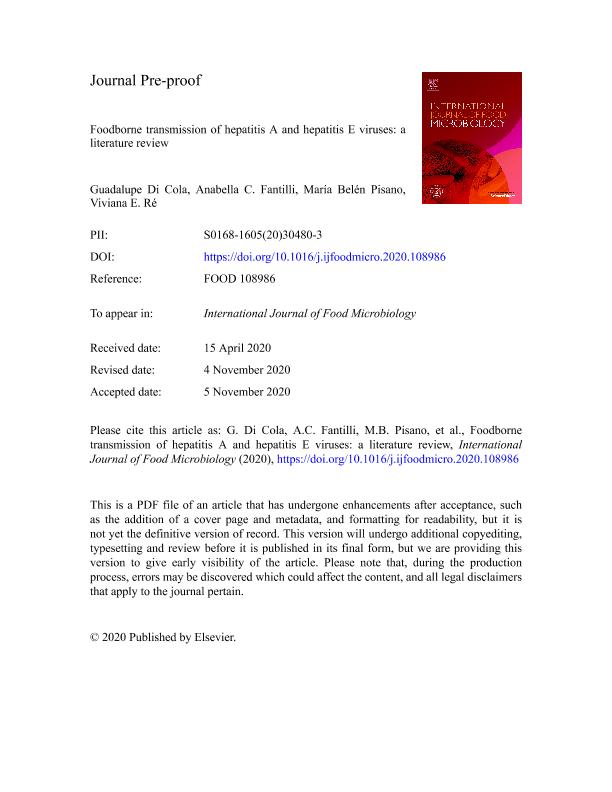Mostrar el registro sencillo del ítem
dc.contributor.author
Di Cola Bucciarelli, Guadalupe

dc.contributor.author
Fantilli, Anabella Clara

dc.contributor.author
Pisano, María Belén

dc.contributor.author
Ré, Viviana Elizabeth

dc.date.available
2021-09-20T16:08:07Z
dc.date.issued
2021-01-02
dc.identifier.citation
Di Cola Bucciarelli, Guadalupe; Fantilli, Anabella Clara; Pisano, María Belén; Ré, Viviana Elizabeth; Foodborne transmission of hepatitis A and hepatitis E viruses: A literature review; Elsevier Science; International Journal of Food Microbiology; 338; 2-1-2021; 1-60
dc.identifier.issn
0168-1605
dc.identifier.uri
http://hdl.handle.net/11336/140889
dc.description.abstract
Foodborne viruses have been recognized as a growing concern to the food industry and a serious public health problem. Hepatitis A virus (HAV) is responsible for the majority of viral outbreaks of food origin worldwide, while hepatitis E virus (HEV) has also been gaining prominence as a foodborne viral agent in the last years, due to its zoonotic transmission through the consumption of uncooked or undercooked infected meat or derivatives. However, there is a lack of scientific reports that gather all the updated information about HAV and HEV as foodborne viruses. A search of all scientific articles about HAV and HEV in food until March 2020 was carried out, using the keywords “HAV”, “HEV”, “foodborne”, “outbreak” and “detection in food”. Foodborne outbreaks due to HAV have been reported since 1956, mainly in the USA, and in Europe in recent years, where the number of outbreaks has been increasing throughout time, and nowadays it has become the continent with the highest foodborne HAV outbreak report. Investigation and detection of HAV in food is more recent, and the first detections were performed in the 1990s decade, most of them carried out on seafood, first, and frozen food, later. On the other hand, HEV has been mainly looked for and detected in food derived from reservoir animals, such as meat, sausages and pate of pigs and wild boars. For this virus, only isolated cases and small outbreaks of foodborne transmission have been recorded, most of them in industrialized countries, due to HEV genotype 3 or 4. Virus detection in food matrices requires special processing of the food matrix, followed by RNA detection by molecular techniques. For HAV, a real-time PCR has been agreed as the standard method for virus detection in food; in the case of HEV, a consensus assay for its detection in food has not been reached yet. Our investigation shows that there is still little data about HAV and HEV prevalence and frequency of contamination in food, prevalent viral strains, and sources of contamination, mainly in developing countries, where there is no research and legislation in this regard. Studies on these issues are needed to get a better understanding of foodborne viruses, their maintenance and their potential to cause diseases.
dc.format
application/pdf
dc.language.iso
eng
dc.publisher
Elsevier Science

dc.rights
info:eu-repo/semantics/openAccess
dc.rights.uri
https://creativecommons.org/licenses/by-nc-nd/2.5/ar/
dc.subject
DETECTION IN FOOD
dc.subject
FOOD
dc.subject
FOODBORNE OUTBREAK
dc.subject
FOODBORNE VIRUSES
dc.subject.classification
Virología

dc.subject.classification
Ciencias Biológicas

dc.subject.classification
CIENCIAS NATURALES Y EXACTAS

dc.title
Foodborne transmission of hepatitis A and hepatitis E viruses: A literature review
dc.type
info:eu-repo/semantics/article
dc.type
info:ar-repo/semantics/artículo
dc.type
info:eu-repo/semantics/publishedVersion
dc.date.updated
2021-09-06T15:09:17Z
dc.identifier.eissn
1879-3460
dc.journal.volume
338
dc.journal.pagination
1-60
dc.journal.pais
Países Bajos

dc.journal.ciudad
Amsterdam
dc.description.fil
Fil: Di Cola Bucciarelli, Guadalupe. Universidad Nacional de Córdoba. Facultad de Medicina. Instituto de Virología Dr. J. M. Vanella; Argentina. Consejo Nacional de Investigaciones Científicas y Técnicas. Centro Científico Tecnológico Conicet - Córdoba; Argentina
dc.description.fil
Fil: Fantilli, Anabella Clara. Universidad Nacional de Córdoba. Facultad de Medicina. Instituto de Virología Dr. J. M. Vanella; Argentina. Consejo Nacional de Investigaciones Científicas y Técnicas. Centro Científico Tecnológico Conicet - Córdoba; Argentina
dc.description.fil
Fil: Pisano, María Belén. Universidad Nacional de Córdoba. Facultad de Medicina. Instituto de Virología Dr. J. M. Vanella; Argentina. Consejo Nacional de Investigaciones Científicas y Técnicas. Centro Científico Tecnológico Conicet - Córdoba; Argentina
dc.description.fil
Fil: Ré, Viviana Elizabeth. Universidad Nacional de Córdoba. Facultad de Medicina. Instituto de Virología Dr. J. M. Vanella; Argentina. Consejo Nacional de Investigaciones Científicas y Técnicas. Centro Científico Tecnológico Conicet - Córdoba; Argentina
dc.journal.title
International Journal of Food Microbiology

dc.relation.alternativeid
info:eu-repo/semantics/altIdentifier/url/https://www.sciencedirect.com/science/article/abs/pii/S0168160520304803
dc.relation.alternativeid
info:eu-repo/semantics/altIdentifier/doi/http://dx.doi.org/10.1016/j.ijfoodmicro.2020.108986
Archivos asociados
